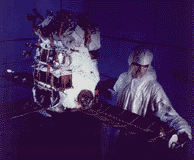ALEXIS
Array of Low-Energy X-ray Imaging Sensors
 ALEXIS is a small spacecraft built for the Los Alamos National Laboratory (LANL). Its mission is to provide high resolution maps of low-energy astronomical x-ray sources. The mission is also intended to demonstrate the feasibility of quickly building low cost sensors for arms treaty verification. The spacecraft's cost is reported to be approximately $17 million. An anomaly caused one of the satellite's four solar panels to break away from the vehicle during launch, causing a temporary loss of the spacecraft. Ground controllers were eventually able to control the spacecraft and begin on-orbit operations.
ALEXIS is a small spacecraft built for the Los Alamos National Laboratory (LANL). Its mission is to provide high resolution maps of low-energy astronomical x-ray sources. The mission is also intended to demonstrate the feasibility of quickly building low cost sensors for arms treaty verification. The spacecraft's cost is reported to be approximately $17 million. An anomaly caused one of the satellite's four solar panels to break away from the vehicle during launch, causing a temporary loss of the spacecraft. Ground controllers were eventually able to control the spacecraft and begin on-orbit operations.
Spacecraft
Four deployed solar panels provide 50 watts average power. Four NiCd batteries. Redundant 80C86 processors. S-Band communications with downlink rate 750 kbps and uplink rate of 9.6 kbps. Mass memory of 100 Mbytes EDAC solid state storage. The bus points the payload in the anti-sun direction and rotates at 2 rpm about that sun-line. Sun sensors and limb sensor provide attitude knowledge of 0.1 deg. Attitude is controlled using magnetic torque coils. Single ground station installed at LANL has 6 ft antenna.
Payload
An ultrasoft X-ray monitor which consists of 6 compact normal-incidence telescopes tuned to narrow bands centered on 66, 71, and 93 eV.
Status as of 1/21/97
ALEXIS continues to operate nominally, sending the results of EUV telescope observations on every pass. ALEXIS has identified a number of transient outbursts in near real time and sometimes is able to supply such target opportunities to operators of the EUVE satellite which contains instruments that are sensitive on similar wavelengths. During occasional "hot times" when ALEXIS is illuminated by the sun during 100% of it's orbit, the telescopes cease operations to avoid overheating the spacecraft (Normally the spacecraft passes through the earth's shadow.) This anomaly is probably caused by a tear in the thermal insulation, associated with the solar panel damage that occurred during launch.
| Country of Origin | United States |
| Customer/User | LANL |
| Manufacturer(s) | AeroAstro |
| Size | Cylinder 1 m high, 60 cm diameter |
| Orbit | 750 km circular, 65 deg inclination |
| Design Life | 1 year, goal of 3 years |
| Related Sites | ALEXIS home page |
Launch Facts
| Name | Int'l Desig. | Date | Site | Vehicle | Orbit | Mass(kg) |
| Notes | ||||||
| Alexis | 1993-026A | 4/25/93 | WSMC | Pegasus | LEO | 115 |
| Test of X-ray imaging sensors; solar array deployment malfunction | ||||||
Information in The Mission and Spacecraft Library is provided without warranty or guarantee. USE AT YOUR OWN RISK.